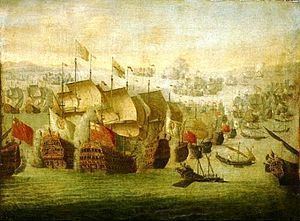1,600 dead or wounded 2,700 dead or wounded Location Málaga, Spain | Date 24 August 1704 | |
 | ||
50 warships
6 frigates
(3,577 guns)
24,275 men 53 ships of the line
6 frigates
7 fireships
28 galleys
(3,614 guns)
22,543 men Result Tactically indecisive; Grand Alliance strategic victory Combatants Dutch Republic, Kingdom of England, Bourbon Spain, Early modern France Similar Battle of Toulon, War of the Spanish Succession, Battle of Calcinato, Battle of Carpi, Battle of Chiari | ||
Battle of m laga 1704
The Battle of Málaga (or Vélez-Málaga) was the largest naval battle in the War of the Spanish Succession. It took place on 24 August 1704, south of Málaga, Spain.
Contents
- Battle of m laga 1704
- The battle
- EnglandNetherlands George Rooke
- Vanguard
- Centre
- Rear
- Others
- Total
- France Toulouse and dEstres
- References
The battle
Less than a week after the Capture of Gibraltar, Admiral George Rooke received intelligence that a French fleet under the command of Toulouse and d'Estrées was approaching Gibraltar. Leaving half his marines to defend the newly won prize, Rooke immediately set off with his combined Anglo-Dutch fleet to engage the French.
The outcome of the action that followed, the Battle of Vélez-Málaga, was indecisive. Not a single vessel was sunk or captured on either side but the mutual battering left many ships barely seaworthy and casualties on both sides were high. As the French and the British approached each other two days later, on 26 August, they finally decided not to engage each other. Considering the British had a significantly higher number of casualties and highly damaged ships, particularly their masts, the French mistakenly interpreted the British fleet's prudence as an overall victory. Byng's squadron, having expended so much ammunition in the previous bombardment of Gibraltar, was obliged to quit the line.
The French had returned to Toulon claiming victory. The reality was, however, that by retreating to Toulon the French turned what had been a tactical stalemate into an Anglo-Dutch strategic victory, because after the Battle of Vélez-Málaga the French Navy never again emerged from Toulon in full strength.
England/Netherlands (George Rooke)
(90-gunners and above were 3-deckers)
Vanguard
Centre
Rear
The rear division comprised the Dutch element of the Anglo-Dutch fleet.
Others
Total
3614 guns, 22543 men
France (Toulouse and d'Estrées)
Vanguard
Centre
Rear
Others
Total
3577 guns, 24275 men
